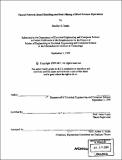| dc.contributor.advisor | Amar Gupta. | en_US |
| dc.contributor.author | Banks, Bradley S. (Bradley Scott), 1974- | en_US |
| dc.contributor.other | Massachusetts Institute of Technology. Dept. of Electrical Engineering and Computer Science. | en_US |
| dc.date.accessioned | 2009-02-17T17:24:30Z | |
| dc.date.available | 2009-02-17T17:24:30Z | |
| dc.date.copyright | 1999 | en_US |
| dc.date.issued | 1999 | en_US |
| dc.identifier.uri | http://hdl.handle.net/1721.1/44600 | |
| dc.description | Thesis (M.Eng.)--Massachusetts Institute of Technology, Dept. of Electrical Engineering and Computer Science, 1999. | en_US |
| dc.description | Includes bibliographical references (leaves 55-57). | en_US |
| dc.description.abstract | Industrial production processes have traditionally been predicted using models whose structure is determined from domain specific knowledge. Steel production is an ex.ample of such a process, where conventional modeling techniques are based on knowledge of the materials and reactions involved. These models have several shortcomings, including the impossibility of constructing precise models, the inability to adapt to changing conditions, and the high cost of development. Because of these limitations, there is growing interest in applying methods which take a data driven approach to modeling these processes. One such method, the Artificial Neural Network (ANN), has been successfully used in many areas. ANNs offer a data driven approach which has potential to produce a more accurate, flexible model in less time and at a lower cost. This model can then be used for simulation, prediction, and control. A case study application of using ANNs to model the production of pig iron, an intermediate step in producing steel, is presented. Two qualitatively different aspects of pig iron production, hot metal temperature and hot metal silicon content, were modeled. Early results indicated the importance of preprocessing the raw data in order to make network learning easier. Modeling efforts focused on the most well known neural network architecture, a feed forward network trained with the back propagation learning algorithm. A neural network software package, NNRUN, was developed to automate the search for the best neural network for a given dataset. The combination of preprocessing and modeling with NNRUN produced models which yielded significantly more accurate predictions than traditional modeling methods. | en_US |
| dc.description.statementofresponsibility | by Bradley S. Banks. | en_US |
| dc.format.extent | 57 leaves | en_US |
| dc.language.iso | eng | en_US |
| dc.publisher | Massachusetts Institute of Technology | en_US |
| dc.rights | M.I.T. theses are protected by
copyright. They may be viewed from this source for any purpose, but
reproduction or distribution in any format is prohibited without written
permission. See provided URL for inquiries about permission. | en_US |
| dc.rights.uri | http://dspace.mit.edu/handle/1721.1/7582 | en_US |
| dc.subject | Electrical Engineering and Computer Science. | en_US |
| dc.title | Neural network based modeling and data mining of blast furnace operations | en_US |
| dc.type | Thesis | en_US |
| dc.description.degree | M.Eng. | en_US |
| dc.contributor.department | Massachusetts Institute of Technology. Department of Electrical Engineering and Computer Science | |
| dc.identifier.oclc | 46311125 | en_US |
